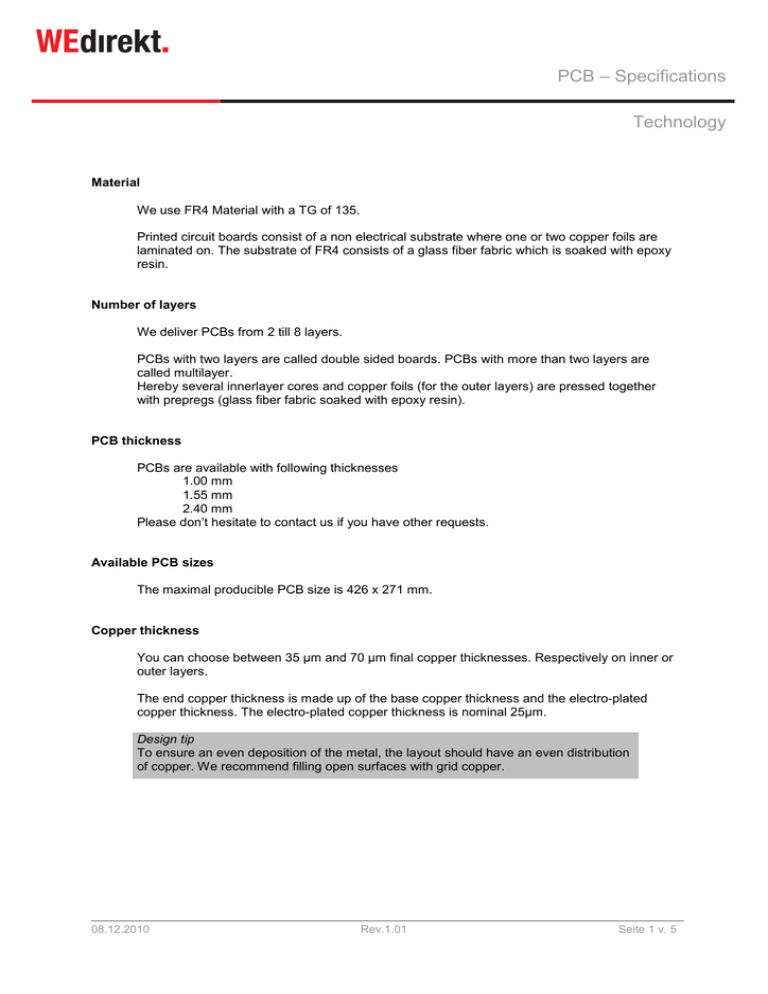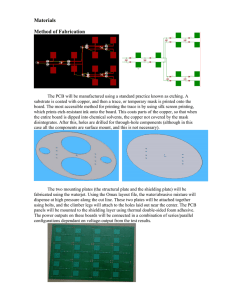PCB – Specifications Technology
advertisement

PCB – Specifications Technology Material We use FR4 Material with a TG of 135. Printed circuit boards consist of a non electrical substrate where one or two copper foils are laminated on. The substrate of FR4 consists of a glass fiber fabric which is soaked with epoxy resin. Number of layers We deliver PCBs from 2 till 8 layers. PCBs with two layers are called double sided boards. PCBs with more than two layers are called multilayer. Hereby several innerlayer cores and copper foils (for the outer layers) are pressed together with prepregs (glass fiber fabric soaked with epoxy resin). PCB thickness PCBs are available with following thicknesses 1.00 mm 1.55 mm 2.40 mm Please don’t hesitate to contact us if you have other requests. Available PCB sizes The maximal producible PCB size is 426 x 271 mm. Copper thickness You can choose between 35 µm and 70 µm final copper thicknesses. Respectively on inner or outer layers. The end copper thickness is made up of the base copper thickness and the electro-plated copper thickness. The electro-plated copper thickness is nominal 25µm. Design tip To ensure an even deposition of the metal, the layout should have an even distribution of copper. We recommend filling open surfaces with grid copper. 08.12.2010 Rev.1.01 Seite 1 v. 5 PCB – Specifications Technology Layout Outer Layers 100µm structures 35µm end copper 125µm structures 35µm end copper 150µm structures 35µm end copper 192µm structures 70µm end copper Track width / track spacing ≥ 100µm / 100µm ≥ 125µm / 125µm ≥ 150µm / 150µm ≥ 150µm / 192µm Spacing pad / pad ≥ 100µm ≥ 125µm ≥ 150µm ≥ 192µm Spacing track / track ≥ 100µm ≥ 125µm ≥ 150µm ≥ 192µm Inner layers 100µm structures 35µm end copper 100µm structures 35µm end copper 100µm structures 35µm end copper 100µm structures 35µm end copper Isolation spacing ≥ 100µm ≥ 125µm ≥ 150µm ≥ 192µm Annular ring To plan the layout data correctly, the pad- or final-Ø should be dimensioned according to the following standard. Pad-Ø = Final-Ø + 0.40 mm This is based on our standard hole-Ø tolerance of +0.10 / -0.05 mm for plated-through holes. Glossary Due to frequent demand, some terms related to annular ring are defined here Pad-Ø Ø of pad area Final-Ø nominal-Ø of the hole, sometimes also called hole-Ø Tool-Ø drill tool-Ø; is defined by us Annular ring solderable ring on finished circuit board Hole-Ø tolerance min. and max. deviation from final-Ø UL-marking Generally, all PCBs will be marked with an UL-marking and manufacturer date (WW/YY), if there is no spacing problem. The positioning will be in the silk screen and the soldermask. If you wish an explicit position, the marking will be placed there. 08.12.2010 Rev.1.01 Seite 2 v. 5 PCB – Specifications Technology Solder mask The solder mask fulfils different functions on the PCB. It serves as protection of the PCB from corrosion, mechanical damage and prevents short circuits and a moistening of certain areas when soldering the PCB. Moreover the solder mask improves electrical characteristics like the dielectric strength. To keep the soldering surfaces free of lacquer, the pads in the solder mask have to be larger than the conductive pattern. We will perform this optimization for you if your layout is not conform with the following standard. Pad-Ø solder mask = Pad-Ø of conductive pattern + 0.15 mm We use a green photosensitive solder mask; tabs can be imaged reliably starting at 70 µm. Finish surface To prevent oxidation of the open copper on the PCB surface and allow perfect soldering, the surface can be protected with several materials. We offer you the following finish surfaces: HAL leadfree with the HotAirLeveling the PCB is dipped in liquid tin. The tin adheres on the copper surface. The redundant tin is blown off by air. Tin (Sn) Silver (Ag) ENIG (Ni/Au) on the surfaces tin, silver and ENIG a thin layer of metal is applied to the PCB surface by an electrochemical process. The advantages are: less thermal load of the PCB compared to HAL, defined thickness of the metal layer and denser structures on the PCB can be processed. leadfree We offer the surface “leadfree” as our cheapest one. In this case we choose the surface HAL leadfree, tin, silver or ENIG by our own. All offered surfaces have a solderability of minimum 12 months. Silk screen The silk screen marks the locations to place the components on the board. The silk screen is also called placement print, legend print, item print or annotation print. Colour: Character height: white ≥125 µm Design tip The character height has to be minimum 125µm to be regularly readable. The distance between the characters has to be minimum 100µm to avoid the coalescence of the colour. The front size has to be 6,5 x character height; the front width has to be 3,5 x character height. To read the print easily the silk screen may not be placed over the soldering surface. If we found such locations we will delete them for you. 08.12.2010 Rev.1.01 Seite 3 v. 5 PCB – Specifications Technology E-test With the e-test the PCBs are checked for electrical defects. Hereby, there is a measuring clamping between endpoints of the power grids to obviate breaks and short circuits. For double sided boards we offer e-test optionally For multilayers (<2 layers) the e-test is inclusive Mechanical treatment A distinction is made between plated-through (PTH) and non-plated-through (NPTH) drills. Plated-through holes as a component drill have the function to solder wired components on the PCB. As a via-hole those drills connect the several layers of a PCB together. Non-plated-through holes do not assume tin solder at the soldering process therefore they stay solder-less and open. Those are used to fix the PCB or will be used for registration holes in the production process. Breakthroughs or slots are routed or nibbled regardless of their state of metallization. If they are not plated-through, they are generally implemented with the outline. If they are platedthrough, they will be implemented either by extra work performed during the first run or by adding another process step. The mechanical processes of routing and scoring are available for processing the circuit board contour. Standard routing tools of 1.60 mm, 2.00 mm and 2.40 mm are used. With scoring, the surface of the PCB is grooved to a defined score-web. The scoring angle is 30°, the standard score-web is 0.30 mm with a tolerance of ±0.10 mm. To avoid forming burrs the spacing between copper and scoring should be at least 0.40 mm (PCB thickness 1.00 mm), 0.50 mm (PCB thickness 1.55 mm) or 0.70 mm (PCB thickness 2.40 mm). This makes it easier to break out the PCBs. Scoring is only possible in horizontal and vertical way. Scoring in diagonal and round way is not possible. After break out the PCB will be extend about 0.30mm (0.15mm per side). The distance between copper and PCB contour has to be at least 0.50mm for scoring and 0.25mm for routing. If this is not considered in your layout we will correct such locations for you. Multiple panel If different circuit boards are already placed in a panel, please use the "panel from file“ option in the configurator. You only need to indicate the dimensions of the delivery panel. If you have the data for a single circuit board which you want in a delivery panel, you can select the "panel with online configuration" option and create the delivery panel. The mechanical process can be realized through scoring or routing, or a combination of both. By routing the PCBs will be hold through a tab. There are standard routing tools with diameter 1.60mm, 2.00mm and 2.40mm available. By scoring the PCBs will be placed edge to edge in the panel. 08.12.2010 Rev.1.01 Seite 4 v. 5 PCB – Specifications Technology General In our specifications we've put together a package for you which offers the best possible value for you. We will be glad to fulfill any additional requirements you might have; we will bill the resulting extra expense accordingly. To avoid further inquiries and additional costs, we especially recommend to create radiuses less than 0.80mm when working on the contours. If you would like to have your layout optimized, we would be glad to do this for you. The hourly rate for this work is € 75.00. We will archive your data. You can place a repeat order in your personal account at any time. You can also order an SMD stencil at any time. We will need to charge € 25.00 for generating and shipping soldering paste data. For technical reasons it is not possible to provide you certificates or documents for delivery. If you need such documents, we will be glad to submit you an offer outside of our pool service. Please ask us about it. 08.12.2010 Rev.1.01 Seite 5 v. 5


